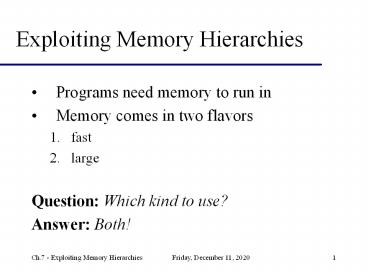Exploiting Memory Hierarchies - PowerPoint PPT Presentation
Title:
Exploiting Memory Hierarchies
Description:
Plus a (relatively) small, quickly accessible cache 'closer to you' Works because programs (vis- -vis memory) exhibit. Temporal Locality. Spatial Locality ... – PowerPoint PPT presentation
Number of Views:118
Avg rating:3.0/5.0
Title: Exploiting Memory Hierarchies
1
Exploiting Memory Hierarchies
- Programs need memory to run in
- Memory comes in two flavors
- fast
- large
- Question Which kind to use?
- Answer Both!
2
Memory Technologies(PH 1997)
Technology Typical access time /MByte
SRAM 5-25 ns 100-250
DRAM 60-120 ns 5-10
Magnetic Disk 10-20 million ns 0.10-0.20
3
Memory TechnologiesTrends
metric 1980 1985 1990 1995 2000 20001980
SRAM /MB 19,200 2,900 320 256 100 190
SRAM access (ns) 300 150 35 15 2 100
DRAM /MB 8,000 880 100 30 1 8,000
DRAM access (ns) 375 200 100 70 60 6
DRAM typical MB 0.064 0.256 4 16 64 1,000
Disk /MB 500 100 8 0.30 0.05 10,000
Disk access (ns) 87 75 28 10 8 11
Disk typical MB 1 10 160 1,000 9,000 9,000
courtesy Randy.Bryant_at_cs.cmu.edu
4
Memory Hierarchy
Speed
Size
Cost (/bit)
CPU
Cache-0
fastest
smallest
highest
Cache-1
Cache-2
slowest
largest
lowest
5
Caching
- Large amount of (slow) memory
- Plus a (relatively) small, quickly accessible
cache closer to you - Works because programs (vis-à-vis memory) exhibit
- Temporal Locality
- Spatial Locality
6
CachingTemporal Locality
- Programs tend to reference recently accessed
memory - instruction memory loops
- Memory hierarchies exploit this by caching
recently-accessed data in close, fast memory
7
CachingSpatial Locality
- Programs tend to reference memory close to
recently-accessed items - Memory hierarchies exploit this by caching
contiguous blocks of data - Well come back to this idea later
8
CachingTerminology
- Hit when data required is found in cache
- Miss when data is not in cache and must be
retrieved from next level of memory - Hit Rate (hit ratio) fraction of memory
accesses that result in hits - Miss Rate fraction of memory accesses that
result in misses
9
CachingTerminology
- Hit Time time to access data in cache(includes
time to determine if data is cached) - Miss Penalty time to replace a block (of
memory) in the cache
10
Caching ModelsDirect-Mapped Cache
- Q. How do we know if an item is in cache? And if
so, how do we find it? - A. Assign each memory location a unique (but not
exclusive) place in the cache
11
Caching ModelsDirect-Mapped Cache
Valid? tag data
00
00
00
00
01
01
01
01
10
10
10
10
11
11
11
11
tag
- cache 4 1-word slots
- memory 16 words (addresses 0000-1111)
12
Caching ModelsDirect-Mapped Cache
- Exercise
- How many cache hits/misses for the following
memory access pattern? - 0010,0011,0110,1110,0000,1111,1001,0110
- What if we had 8 cache slots instead of 4?
13
Caching ModelsCache Misses Reading vs. Writing
- What if program writes (rather than reads) a
memory location? - write-through (the cache to next level)
- write-buffer (buffer of pending writes)
- write-back (to next level before entry replaced)
14
Caching ModelsExploiting Spatial Locality
- So far, cache only exploits temporal locality
- Can exploit spatial locality by caching blocks of
contiguous words, rather than singles
15
Caching ModelsDirect-Mapped Cache
00
00
00
00
01
01
01
01
10
10
10
10
11
11
11
11
tag/word 00 01 10 11
V? W? tag data data data data
- cache 4 4-word slots
- memory 64 words (addresses 000000-111111)
16
Caching ModelsOther mapping models
- Fully-associative
- No strict mapping from memory to cache line
- Cached entries retained longest, extra overhead
to determine presence - Set-associative
- mix of direct-mapping and associative
17
Caching ModelsOther mapping models
- How to determine which cache entry to replace?
- Least-recently used (LRU)(not always best, but
simplest)
18
Virtual Memory
- Caching, but for a different purpose
- Physical memory as a cache for virtual memory
(disk-resident program memory) - Allows program(s) to address more than physical
dimensions of memory
19
Virtual MemoryTranslation-lookaside Buffer (TLB)
- Cache of recently translated (physical ? virtual)
addresses - No larger (usually smaller) than number of lines
in memory.































